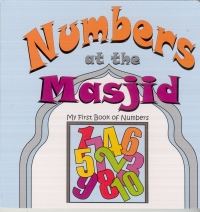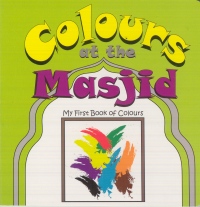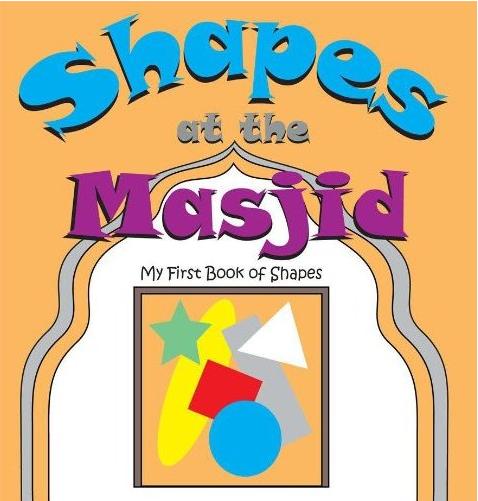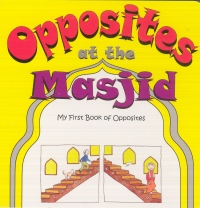| ________________
CM . . . . Volume XVII Number 30 . . . . April 8, 2011

 |
At the Masjid Learning Series.
Katherine Bullock writing as Umm Zakaria, Umm Tariq & Umm Yousef. Illustrated by Heather Greenwood.
Mississauga, ON: Compass Books, 2009-2010.
4 vol. boxed set, each vol. 10 pp, board books, $15.00 for the boxed set or $4.00 each.
Contains:
Numbers at the Masjid: My First Book of Numbers.
Colours at the Masjid: My First Book of Colours.
Shapes at the Masjid: My First Book of Shapes.
Opposites at the Masjid: My First Book of Opposites.
Preschool / Ages 1-3.
Review by Dave Jenkinson.
*** /4 |
| |
|
 |
At the Masjid Learning Series.
Katherine Bullock writing as Umm Zakaria, Umm Tariq & Umm Yousef. Illustrated by Heather Greenwood.
Mississauga, ON: Compass Books, 2009-2010.
4 vol. boxed set, each vol. 10 pp, board books, $15.00 for the boxed set or $4.00 each.
Contains:
Numbers at the Masjid: My First Book of Numbers.
Colours at the Masjid: My First Book of Colours.
Shapes at the Masjid: My First Book of Shapes.
Opposites at the Masjid: My First Book of Opposites.
Preschool / Ages 1-3.
Review by Dave Jenkinson.
*** /4 |
| |
|
 |
At the Masjid Learning Series.
Katherine Bullock writing as Umm Zakaria, Umm Tariq & Umm Yousef. Illustrated by Heather Greenwood.
Mississauga, ON: Compass Books, 2009-2010.
4 vol. boxed set, each vol. 10 pp, board books, $15.00 for the boxed set or $4.00 each.
Contains:
Numbers at the Masjid: My First Book of Numbers.
Colours at the Masjid: My First Book of Colours.
Shapes at the Masjid: My First Book of Shapes.
Opposites at the Masjid: My First Book of Opposites.
Preschool / Ages 1-3.
Review by Dave Jenkinson.
*** /4 |
| |
|
 |
At the Masjid Learning Series.
Katherine Bullock writing as Umm Zakaria, Umm Tariq & Umm Yousef. Illustrated by Heather Greenwood.
Mississauga, ON: Compass Books, 2009-2010.
4 vol. boxed set, each vol. 10 pp, board books, $15.00 for the boxed set or $4.00 each.
Contains:
Numbers at the Masjid: My First Book of Numbers.
Colours at the Masjid: My First Book of Colours.
Shapes at the Masjid: My First Book of Shapes.
Opposites at the Masjid: My First Book of Opposites.
Preschool / Ages 1-3.
Review by Dave Jenkinson.
*** /4 |
| |
|

On the Compass Books' website (www.compassbooks.ca), Katherine Bullock, the series author, explains the origin of this board book series and her purposes in writing it.
As I read countless board books about numbers, colours, shapes and opposites, to my then 18-month old (first-born) son, I yearned for board books of similar quality in English about things to do with Islam. I wanted him to grow up in Canada loving the masjid, and so I thought of a book that would bring these two wishes together: a book about a masjid and a first book about numbers. The idea grew in my mind into a whole series, and churned away through the birth of my second and third children. Finally, after seven years, the opportunity to found Compass Books came along, and with blessings from Heaven, encouragement from Tammy [Soumas, one of the co-founders of Compass Books], and the very special talents of Heather, the illustrator, the "At the Masjid Learning Series" has come to be.
I hope that the book would serve a dual purpose: helping Muslim kids become familiar with the masjid, and provide a book which public school teachers would feel comfortable using in their classrooms as multi-cultural enrichment material. I used the word 'masjid' in the title, rather than 'mosque,' as a way to introduce the more authentic Arabic word, which is commonly used amongst Muslims for our houses of worship.
I "gave" each of my children their "own" book, and so the author of the "Numbers" book is "Umm Zakaria" - Arabic for "the mother of Zakaria" - "Colours" is "Umm Tariq", "Shapes is "Umm Yousef", and since I only have three children, the fourth is mine, "Opposites in the Masjid."
As a body of writing, children's literature should serve its readers as both a mirror and a window. I grew up in a single parent home in the late 1940's and early 1950's, and I found absolutely no books that mirrored my lived experience. Yes, there were some books that portrayed children in a home where there was only one parent, but that situation was always the result of one parent being deceased. Both of my parents were alive; they just weren't living together. Lest you think this review is becoming just a form of personal therapy, my "confession" does have a purpose. It's my way of saying that I fully understand Katherine Bullock's stance of wanting her children, members of a minority, to see their lives mirrored in the books they encounter. And at the same time, I understand Bullock's desire to have her books become windows for others to see into the lives of her children.
As the books' titles indicate, all of the examples of numbers, colours, shapes and opposites are drawn from the context of the "masjid." In case you missed it while reading Bullock's opening words, she explained why she elected to use the word "masjid" as opposed to "mosque." "I used the word 'masjid' in the title, rather than 'mosque,' as a way to introduce the more authentic Arabic word, which is commonly used amongst Muslims for our houses of worship."
Now, if these books were just four mirrors and windows for toddlers into one aspect of Muslim life, I would have likely given the books four stars and a "Highly Recommended" summary statement. But the first word in the title of each of the books (numbers, colours, shapes & opposites) indicates that the books have an additional "teaching" purpose, and the books' subtitles further define the books' scope. These are "My First Book of..." volumes, and that wording suggests that they are appropriate to be utilized by parents or other adults in initially introducing or "teaching" the basics of the four concept areas to very young children.
 Numbers at the Masjid covers the numbers from 1 to 10, and, with two exceptions, each number is treated via its own page. The numbers 5 & 6 share a double page spread while 9 & 10 are placed together on a single page. In both of these instances, the "items" to be counted are boys and girls, and non-Muslim children will need to understand that the children with head coverings are female. The illustration for "Here is 1 masjid" shows the whole building, but its "parts" are separated in a way that could leave the young reader wondering what it is that s/he is to be counting.
Numbers at the Masjid covers the numbers from 1 to 10, and, with two exceptions, each number is treated via its own page. The numbers 5 & 6 share a double page spread while 9 & 10 are placed together on a single page. In both of these instances, the "items" to be counted are boys and girls, and non-Muslim children will need to understand that the children with head coverings are female. The illustration for "Here is 1 masjid" shows the whole building, but its "parts" are separated in a way that could leave the young reader wondering what it is that s/he is to be counting.
While Greenwood has accurately illustrated Bullock's "Inside the masjid there are 3 pairs of shoes on the shelf", "pairs" is a concept that may be unfamiliar to those using a "first" book. What is to be counted in "and 4 taps for making wudu" is quite clear, but non-Muslim parents and other adults will need to research the expression "making wudu" if they are to answer the questions that will likely come from the young children with which they are sharing this book. The numbers 7 and 8 are good examples of what should be found in a beginner counting book as the books and windows, the items to be counted, are easily identified. The book's last page simply repeats the numbers, but with nothing to count. Overall, Numbers at the Masjid is an acceptable "number" book, but it is not the first one that I would use in introducing a young child to numbers and counting.
 Colours at the Masjid introduces blue, brown, red, black, green, yellow, purple, white and orange with all of the colours, but one, being treated on a single page. The exception, green, is a double page spread of the interior of a masjid. Overall, Colours at the Masjid is successful in achieving its intent though the concepts of black and white might have been more easily understood if the two colours had been treated on facing pages. My only other small criticism is that the illustrations of three of the colours evidence shades which might leave a beginning colour-identifier wondering which one is the "real" blue, brown or green.
Colours at the Masjid introduces blue, brown, red, black, green, yellow, purple, white and orange with all of the colours, but one, being treated on a single page. The exception, green, is a double page spread of the interior of a masjid. Overall, Colours at the Masjid is successful in achieving its intent though the concepts of black and white might have been more easily understood if the two colours had been treated on facing pages. My only other small criticism is that the illustrations of three of the colours evidence shades which might leave a beginning colour-identifier wondering which one is the "real" blue, brown or green.
 Shapes at the Masjid presents six shapes: rectangle, square, triangle, oval, circle and star. With one exception, each shape is dealt via a pair of facing page. On one page can be found the targeted shape, and on the other is an illustration of something found in the masjid that also bears the desired shape. This approach of example/application is very effective. Unfortunately, the one departure from this pattern is much less successful. A double page spread of a prayer rug includes both a triangle and an oval. Overall, this illustration is too detailed for the young shape-finder. Illustrator Greenwood adds a nice twist to this book by adding a cat to each of the illustrations, and youngsters will undoubtedly seek it out.
Shapes at the Masjid presents six shapes: rectangle, square, triangle, oval, circle and star. With one exception, each shape is dealt via a pair of facing page. On one page can be found the targeted shape, and on the other is an illustration of something found in the masjid that also bears the desired shape. This approach of example/application is very effective. Unfortunately, the one departure from this pattern is much less successful. A double page spread of a prayer rug includes both a triangle and an oval. Overall, this illustration is too detailed for the young shape-finder. Illustrator Greenwood adds a nice twist to this book by adding a cat to each of the illustrations, and youngsters will undoubtedly seek it out.
 The opposites in Opposites at the Masjid are outside/inside, big/small, short/tall, old/young, up/down and day/night. Most of the illustrations effectively represent the contrasts although the big/small could pose problems for concrete reasoning tykes who will be unable to mentally complete the rest of the body of the "big" boy. The following pair of illustrations for short/tall might be more likely to be labelled "small/big" by children who have not previously had the book's text read to them.
The opposites in Opposites at the Masjid are outside/inside, big/small, short/tall, old/young, up/down and day/night. Most of the illustrations effectively represent the contrasts although the big/small could pose problems for concrete reasoning tykes who will be unable to mentally complete the rest of the body of the "big" boy. The following pair of illustrations for short/tall might be more likely to be labelled "small/big" by children who have not previously had the book's text read to them.
Despite some shortcomings as "first" books, the four books in the "At the Masjid Learning Series" do have a place in home libraries and those book collections that serve a preschool audience. A fine reminder of Canada's multicultural citizenship, the books will reinforce and extend children's understandings of the four concept areas.
Recommended.
Dave Jenkinson, CM's editor, lives in Winnipeg, MB.
 To comment
on this title or this review, send mail to cm@umanitoba.ca. To comment
on this title or this review, send mail to cm@umanitoba.ca.
Copyright © the Manitoba Library Association. Reproduction for personal
use is permitted only if this copyright notice is maintained. Any
other reproduction is prohibited without permission.
NEXT REVIEW |
TABLE OF CONTENTS FOR THIS ISSUE
- April 8, 2011.
AUTHORS |
TITLES |
MEDIA REVIEWS |
PROFILES |
BACK ISSUES |
SEARCH |
CMARCHIVE |
HOME |




 Numbers at the Masjid covers the numbers from 1 to 10, and, with two exceptions, each number is treated via its own page. The numbers 5 & 6 share a double page spread while 9 & 10 are placed together on a single page. In both of these instances, the "items" to be counted are boys and girls, and non-Muslim children will need to understand that the children with head coverings are female. The illustration for "Here is 1 masjid" shows the whole building, but its "parts" are separated in a way that could leave the young reader wondering what it is that s/he is to be counting.
Numbers at the Masjid covers the numbers from 1 to 10, and, with two exceptions, each number is treated via its own page. The numbers 5 & 6 share a double page spread while 9 & 10 are placed together on a single page. In both of these instances, the "items" to be counted are boys and girls, and non-Muslim children will need to understand that the children with head coverings are female. The illustration for "Here is 1 masjid" shows the whole building, but its "parts" are separated in a way that could leave the young reader wondering what it is that s/he is to be counting.  Colours at the Masjid introduces blue, brown, red, black, green, yellow, purple, white and orange with all of the colours, but one, being treated on a single page. The exception, green, is a double page spread of the interior of a masjid. Overall, Colours at the Masjid is successful in achieving its intent though the concepts of black and white might have been more easily understood if the two colours had been treated on facing pages. My only other small criticism is that the illustrations of three of the colours evidence shades which might leave a beginning colour-identifier wondering which one is the "real" blue, brown or green.
Colours at the Masjid introduces blue, brown, red, black, green, yellow, purple, white and orange with all of the colours, but one, being treated on a single page. The exception, green, is a double page spread of the interior of a masjid. Overall, Colours at the Masjid is successful in achieving its intent though the concepts of black and white might have been more easily understood if the two colours had been treated on facing pages. My only other small criticism is that the illustrations of three of the colours evidence shades which might leave a beginning colour-identifier wondering which one is the "real" blue, brown or green. Shapes at the Masjid presents six shapes: rectangle, square, triangle, oval, circle and star. With one exception, each shape is dealt via a pair of facing page. On one page can be found the targeted shape, and on the other is an illustration of something found in the masjid that also bears the desired shape. This approach of example/application is very effective. Unfortunately, the one departure from this pattern is much less successful. A double page spread of a prayer rug includes both a triangle and an oval. Overall, this illustration is too detailed for the young shape-finder. Illustrator Greenwood adds a nice twist to this book by adding a cat to each of the illustrations, and youngsters will undoubtedly seek it out.
Shapes at the Masjid presents six shapes: rectangle, square, triangle, oval, circle and star. With one exception, each shape is dealt via a pair of facing page. On one page can be found the targeted shape, and on the other is an illustration of something found in the masjid that also bears the desired shape. This approach of example/application is very effective. Unfortunately, the one departure from this pattern is much less successful. A double page spread of a prayer rug includes both a triangle and an oval. Overall, this illustration is too detailed for the young shape-finder. Illustrator Greenwood adds a nice twist to this book by adding a cat to each of the illustrations, and youngsters will undoubtedly seek it out. The opposites in Opposites at the Masjid are outside/inside, big/small, short/tall, old/young, up/down and day/night. Most of the illustrations effectively represent the contrasts although the big/small could pose problems for concrete reasoning tykes who will be unable to mentally complete the rest of the body of the "big" boy. The following pair of illustrations for short/tall might be more likely to be labelled "small/big" by children who have not previously had the book's text read to them.
The opposites in Opposites at the Masjid are outside/inside, big/small, short/tall, old/young, up/down and day/night. Most of the illustrations effectively represent the contrasts although the big/small could pose problems for concrete reasoning tykes who will be unable to mentally complete the rest of the body of the "big" boy. The following pair of illustrations for short/tall might be more likely to be labelled "small/big" by children who have not previously had the book's text read to them.